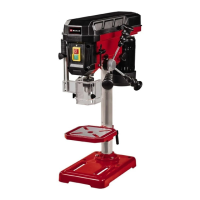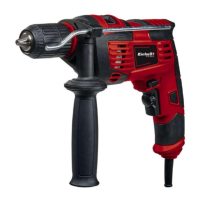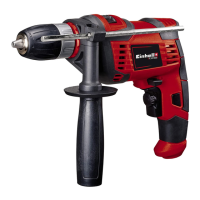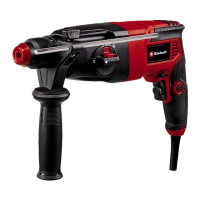- 33 -
6.4 Speed settings (Fig. 12/14-16)
First switch o the machine, then pull out the
power plug.
The various spindle speeds can be set by chan-
ging the position of the V-belt.
Proceed as follows:
•
First move the fastening rail for the chip guard
(23) into the lowest position so that the V-belt
cover can be fully opened. To do so, undo the
securing screw of the chip guard (22) to ena-
ble the fastening rail for the chip guard to be
pushed downwards (Fig. 12).
•
Slacken the locking screw (15) so that you
can open the V-belt cover (7) and then sla-
cken the tightening screw (16) on the machi-
ne head (6) (Fig. 14).
•
Turn the clamping lever (17) clockwise to re-
move tension from the V-belt (26) (Fig. 15a).
•
Change the position of the V-belt to suit the
required speed.
•
Please refer to the table (Fig. 16) for the cor-
responding speeds.
•
Re-tension the V-belt by turning the clamping
lever counter-clockwise (Fig.15b).
Note: The tension is properly set when you
can depress the V-belt in the middle by ap-
prox. 1 cm.
•
Then re-tighten the tightening screw on the
machine head.
•
Re-close the V-belt cover and tighten with the
locking screw.
Note: The V-belt cover must always be shut tight
because the machine is equipped with a safety
switch that allows the machine to be switched on
only when the V-belt cover is closed.
Danger! Never let the pillar drill run when the V-
belt cover is open. Always pull power plug before
opening the cover. Never touch the V-belt when it
is rotating.
6.5. Drill depth stop (Fig. 17)
The drilling spindle has a swiveling scale ring for
setting the drilling depth. Adjust the settings only
when the machine is at a standstill.
•
Press the drilling spindle (11) downwards until
the tip of the drill bit touches the workpiece.
•
Slacken the clamping screw (14) and turn the
scale ring (25) forwards until it stops.
•
Turn the scale ring back to the required dril-
ling depth and lock this setting with the clam-
ping screw.
6.6 Setting the angle of the drill table (Fig.
18)
•
Slacken the carriage bolt (28) under the drill
table (4) with the help of the supplied Hex Key
(29).
•
Set the drill table (4) to the desired angle.
•
Tighten down the carriage bolt (28) in order to
lock the drill table (4) into this position.
6.7 Setting the height of the drill table (Fig.
19)
•
Slacken the tightening screw (5).
•
Set the drill table (4) to the desired height by
pressing down or lifting up and simultaneous-
ly (gently) pushing to the left or right.
•
Screw the tightening screw (5) back down
again.
6.8 Clamping the workpiece
As a general rule, use a machine vice or another
suitable clamping device to lock a workpiece into
position. Never hold the workpiece in place
with your hand! When drilling, the workpiece
should be able to travel on the drill table (4) for
self-centering purposes. Ensure that the workpie-
ce cannot rotate. This is best achieved by placing
the workpiece/machine vice on a sturdy block.
Danger! Sheetmetal parts must be clamped in to
prevent them from being torn up. Properly set the
height and angle of the drill table for each workpi-
ece. There must be enough distance between the
upper edge of the workpiece and tip of the drill bit.
6.9 Working speeds
Ensure that you drill at the proper speed. Drill
speed is dependent on the diameter of the drill bit
and the material it is made from.
The table below acts as a guide for selecting
the proper speed for drill bits made from various
materials.
Note: The rotational speeds shown are me-
rely suggested values.
Drill bit Ø Cast iron Steel Iron Aluminum Bronze
3 2550 1600 2230 9500 8000
4 1900 1200 1680 7200 6000
5 1530 955 1340 5700 4800
6 1270 800 1100 4800 4000
7 1090 680 960 4100 3400
8 960 600 840 3600 3000
9 850 530 740 3200 2650
10 765 480 670 2860 2400
11 700 435 610 2600 2170
Anl_SA_TC_BD_450_SPK8.indb 33Anl_SA_TC_BD_450_SPK8.indb 33 19.07.2022 13:18:2919.07.2022 13:18:29

